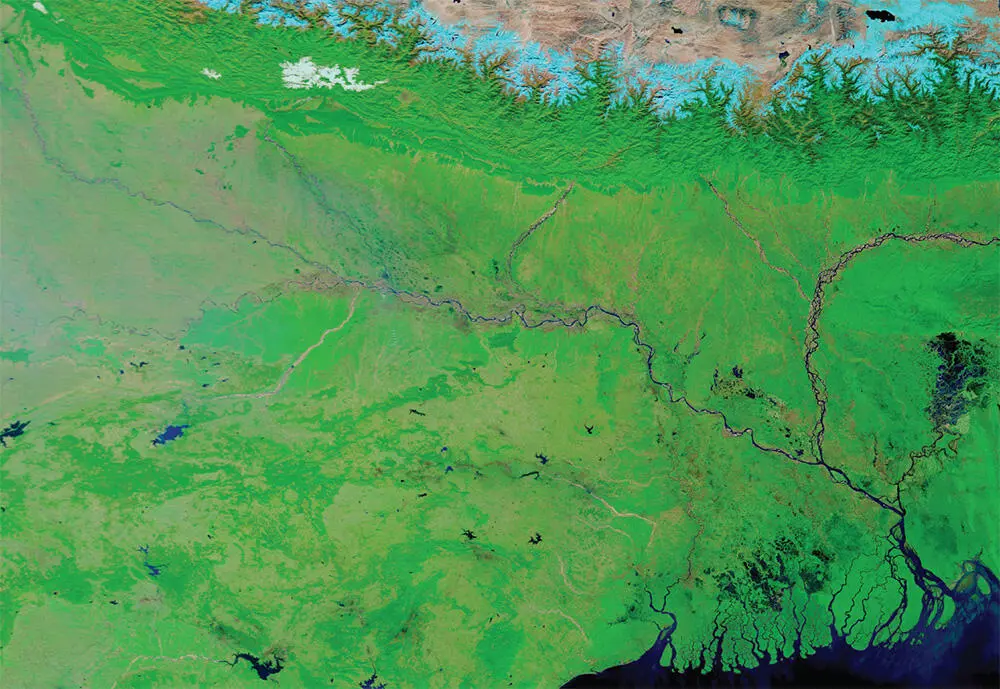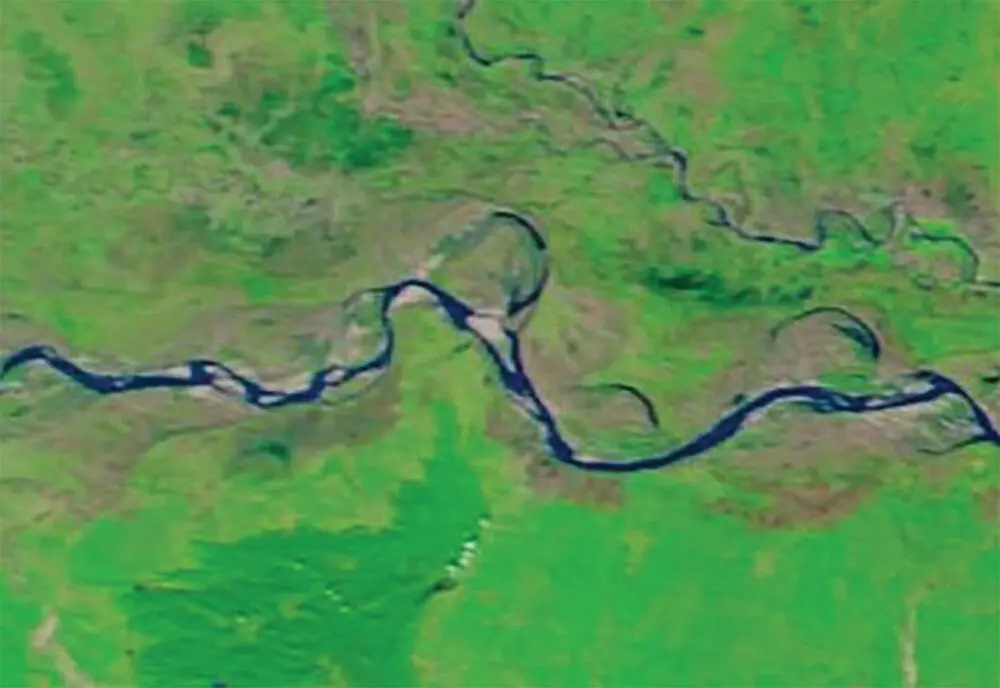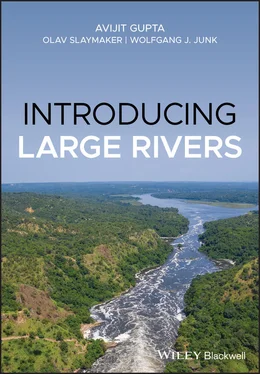The Ganga turns east and flows along a wide alluvial plain built on the foreland by the main river and its tributaries ( Figure 4.7). The river receives both water and sediment from the Himalayas to the north and the cratons of the Peninsular India to the south. All along its course, the river is joined from the north by a number of large Himalayan tributaries at intervals of hundreds of kilometres. The Ganga and these tributaries have built huge alluvial fans (megafans) at the Himalayan highland–lowland contact. Some of these megafans have been studied in detail, e.g. the Kosi ( Box 4.1).
The tributaries from the south drain the old rocks of the northern edge of the Indian Peninsula, contributing a smaller amount of water and coarser sediment. Several of these tributary streams flow into the Yamuna, the biggest tributary of the Ganga, instead of directly joining the Ganga. The Yamuna is a Himalayan river and at its confluence with the Ganga at Allahabad, it contributes about 59% of a combined discharge of 130 × 10 m 3(Das Gupta 1984).
The Ganga turns south at the eastern margin of its large alluvial plain through a gap in the basaltic low hills of Rajmahal, a short distance above the apex of its delta. One of its two main distributaries (the Bhagirathi or Hugli) flows south within India, collecting drainage from the northeastern corner of the Indian Peninsula. The other major distributary, the Padma, carries most of the water into Bangladesh where it meets with the Brahmaputra and then the Meghna. These three rivers combine to build and maintain the large Ganga-Brahmaputra Delta.

Figure 4.7 The Ganga from satellite imagery.
Source: NASA Worldview application ( https://worldview.earthdata.nasa.gov), part of the NASA EOSDIS.
The Ganga essentially is a rainfed seasonal river sustained by the summer rain of the Indian monsoon. The annual total rainfall decreases from the east to west, from 1600 to 500 mm. The southwestern basin is relatively dry. As expected, rainfall increases on the Himalayan slopes, reaching 1500–2300 mm (Singh 2007). The upper basin also receives some summer snowmelt from the Himalaya. More than 70% of the annual rainfall, rising to 80% in certain locations, arrives between July and early October in the wet monsoon system. The rain often falls intensely and in episodic tropical storms, some reaching cyclonic status, over the lower basin leading to floods.
The flow of the Ganga reflects both seasonality of rainfall and stepwise increment in discharge where the major tributaries, such as the Yamuna, Gomati, Ghaghara, Gandak, Son, and Kosi join the trunk steam. Half of the annual rainfall enters the river as surface runoff, 30% is lost by evaporation, and 20% seeps to the subsurface. During the dry season, part of the subsurface water flows through the high alluvial banks of the Ganga to its channel as baseflow. The mean discharge of the Ganga at Farakka, before it divides into its deltaic distributaries, is 70 547 m 3s −1. About 60% of this arrives from the Himalaya and the northern plains (Das Gupta 1984).
The sediment load of the Ganga comes mostly from the tectonic Himalaya Mountains. Chemical weathering is not significant in the mountains and the solution load is low, being diluted even further when the discharge is high in the wet monsoon. The suspended and bed load of the Ganga is very high, the suspended load the second highest in the world, superseded only by the Amazon. The annual suspended load of the Ganga has been estimated by Milliman and Syvitski (1992) as 520 million tonnes. About 90% of the sediment travels during the wet monsoon (Singh 2007). The bed load of a large river is difficult to measure but Wasson has estimated that 600–2500 million tonnes of bed load reaches the delta of the river each year. Most of the sediment arrives in the Ganga from the Himalayas along the large tributaries that originate in the mountains and the foothills (Sinha and Friend 1994). The tributaries that come from the south drain the old cratonic rocks of Peninsular India and contribute a high proportion of coarse sediment.
The change in bed material of the Ganga from Haridwar at the foot of the Himalaya Mountains to Ganga Sagar where one of the major distributary channels, the Hugli, enters the Bay of Bengal is plotted in Figure 3.5. Measured from bar samples, it indicates the general downstream fining characteristic of the Ganga, interrupted by periodic coarsening of the bed by contributions from large tributaries (Singh 1996). The bar sediment of the Ganga is essentially sand, the mineralogy of which is primarily quartz with minor amounts of feldspars, micas, and rock fragments. Material from the weathered source-rocks undergoes further alteration when grains are stored as part of floodplain alluvium between their transportation in high flows (Wasson 2003).
In the Himalaya Mountains, Ganga and its headwater tributaries flow in narrow, gorge-like valleys flanked by small discontinuous patches of floodplains and terraces. After emerging from the mountains, in the wide alluvial plain between the Himalaya and the cratonic Peninsular India, the rivers are entrenched below the surface of the plain. The channel of the Ganga is confined within a 10–25 km wide elongated lowland, bounded by alluvial cliffs, several metres high. The cliffs are eroded by gullies and small ravines. The lowland bounded by the cliffs comprise: (i) the channel of the Ganga commonly displaying braid bars and meander scars, (ii) the floodplain, (iii) terrace-like features which are higher than the floodplain, and (iv) miscellaneous wetlands. The river channel and the floodplain together extend up to 3 km in width. Large sand bars, kilometres in length, are common in the channel. The Ganga remains confined within this cliff-bounded valley and rarely overtops the cliffs, even in large floods. The floodplain and terrace-like features, however, are inundated periodically, the frequency depending on their height above the channel. The channel pattern of the Ganga changes from place to place ( Figure 4.8), and the wide valley between alluvial cliffs is modified by various agencies: the main channel of the Ganga; the smaller channels; the miscellaneous water bodies on the floodplain; and the alteration of the cliff slopes.
Being a seasonal river, the channel of the Ganga is full of bars and multiple channels in the dry season. Huge kilometre-scale bars consisting of braid bars, lateral bars, and point bars are visible at low flow. The low flow effect is enhanced by the large-scale transfer of water into irrigation canals or to meet other demands. In places, the river displays a meandering pattern with point bars and local narrowing of the channel due to extensions of peninsular lineaments under alluvium. The river may briefly change its direction in such locations. The meandering pattern using the entire channel commonly appears in high flows when nearly the entire channel is under water and mid-channel bars are submerged and removed. During the dry season, however, a braided pattern may re-emerge between the cliffs, as has been described for the Narmada (Gupta et al. 1999), for rivers of monsoon areas.

Figure 4.8 The Ganga from satellite imagery in alluvium, bars and bends.
Source: NASA Worldview application ( https://worldview.earthdata.nasa.gov), part of the NASA EOSDIS.
Читать дальше














